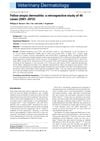Pollen Allergies in Humans and Their Dogs, Cats, and Horses: Differences and Similarities
January 2015
in “
Clinical and Translational Allergy
”
TLDR Humans and pets share similar allergy mechanisms, and studying pet allergies can help treat both human and animal allergies.
The document compared pollen allergies in humans and domestic animals (dogs, cats, and horses), noting similarities in IgE receptor patterns and cell types involved in allergic reactions. Humans primarily experienced allergic rhinitis, while dogs suffered from atopic dermatitis, horses from recurrent airway obstruction or hives, and cats from bronchial asthma and pruritic dermatitis. Diagnostic methods varied, with humans using skin tests and allergen-specific IgE detection, and animals relying on intradermal tests. Allergen immunotherapy was effective across species, suggesting domestic animals could serve as valuable models for translational allergy studies.
